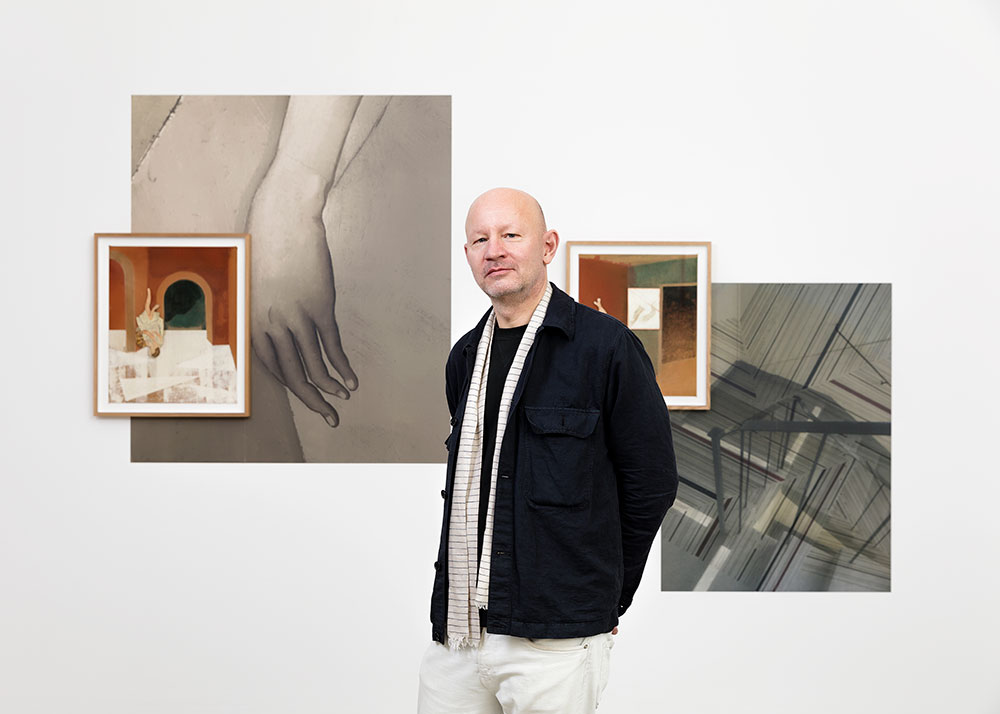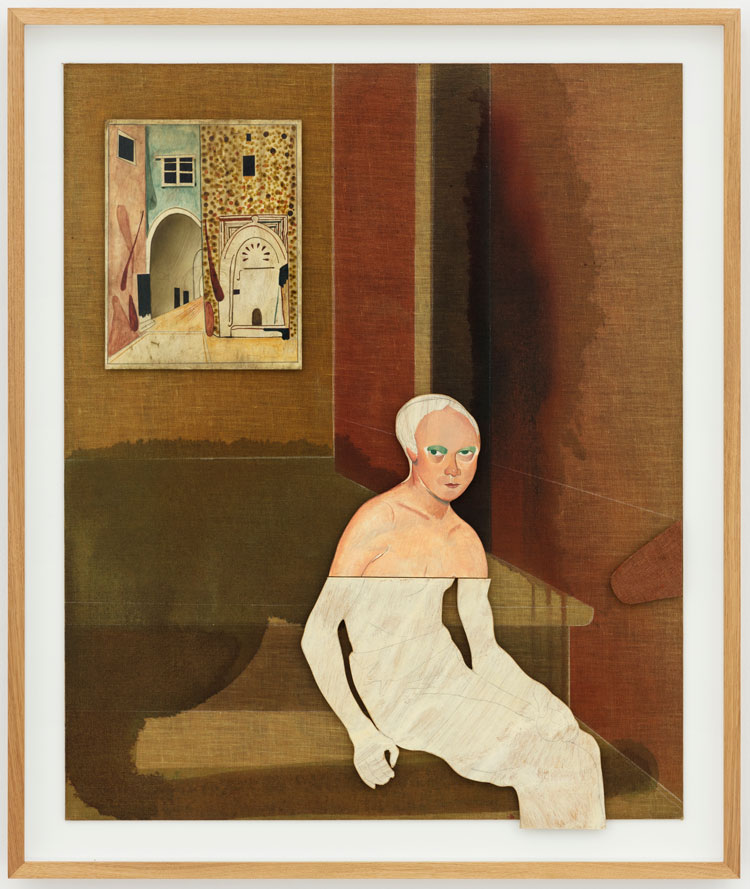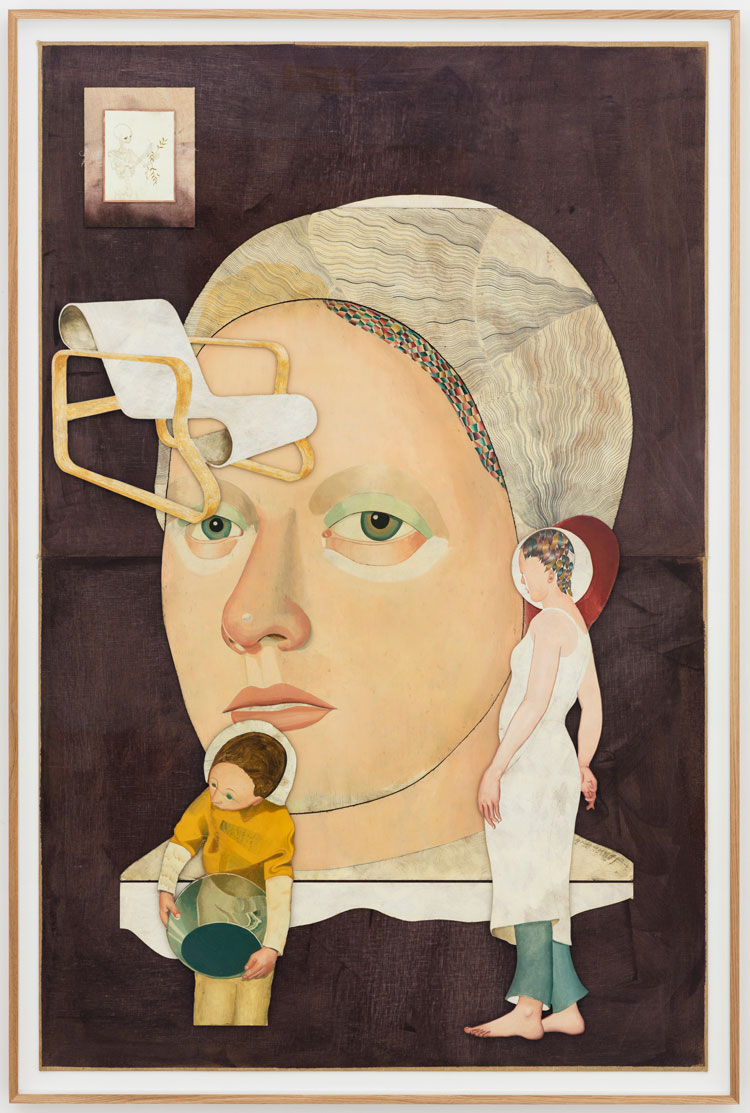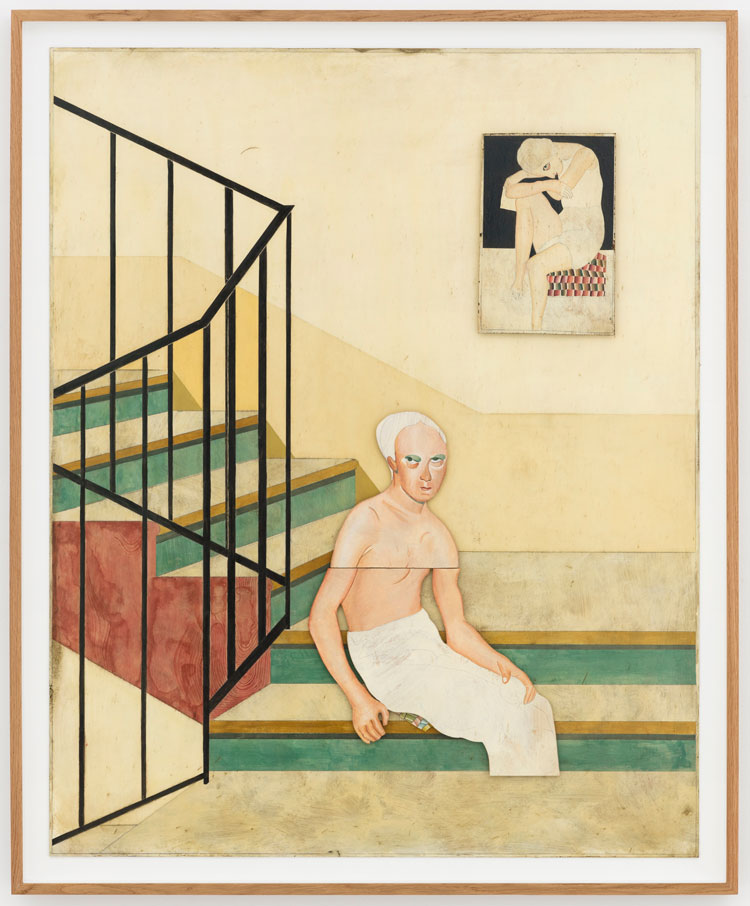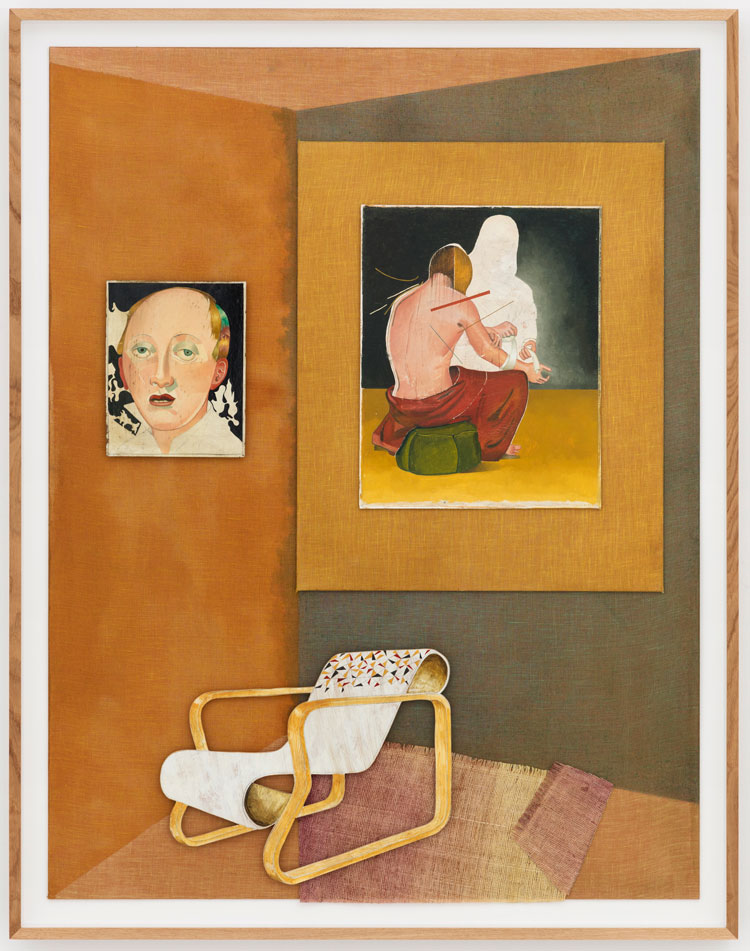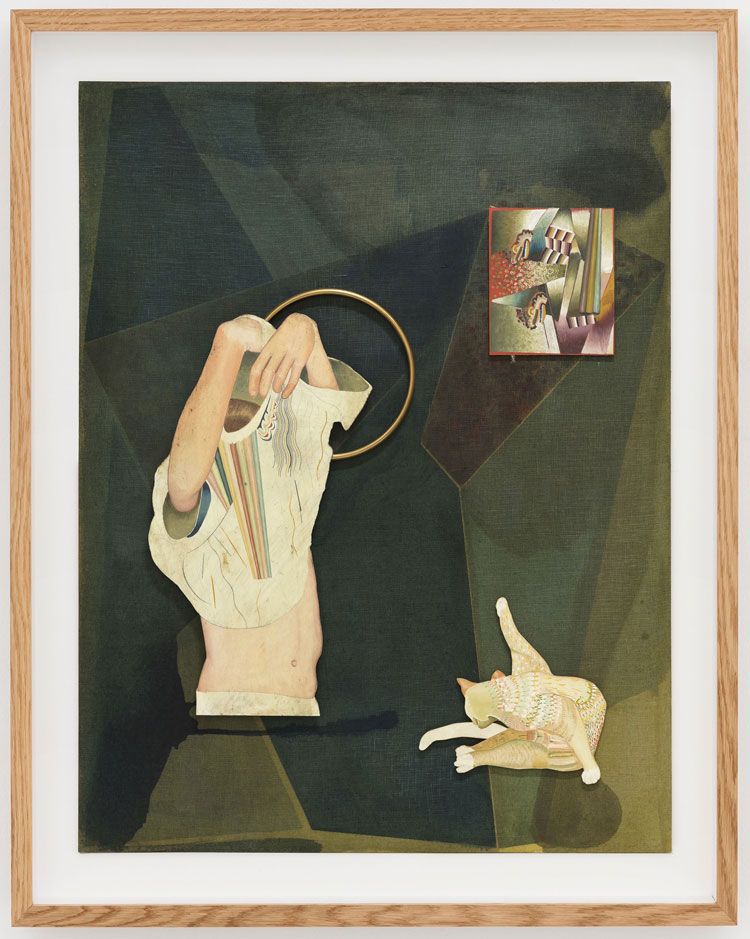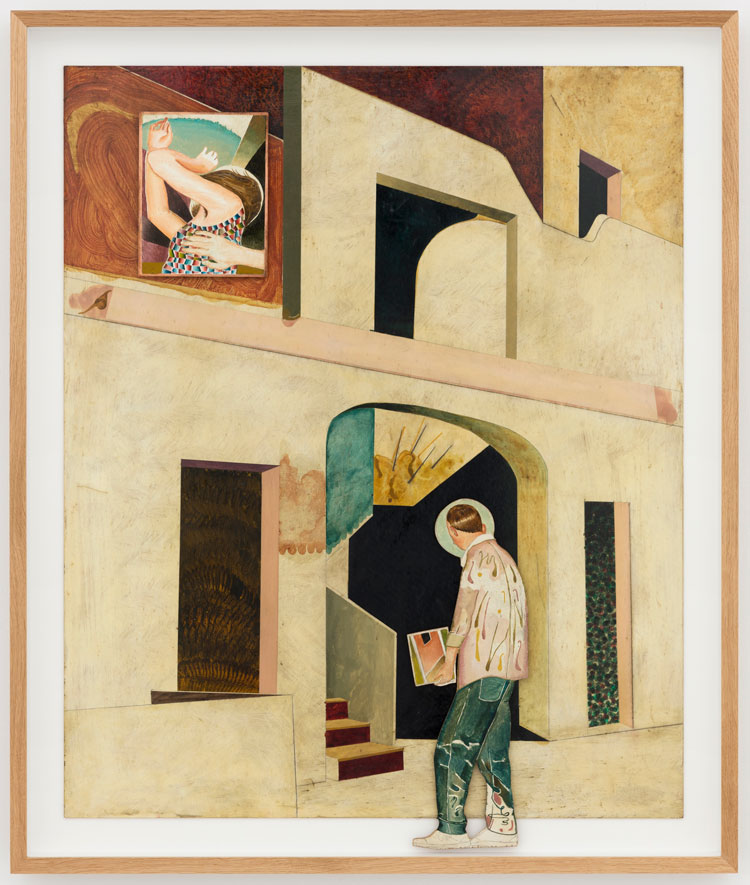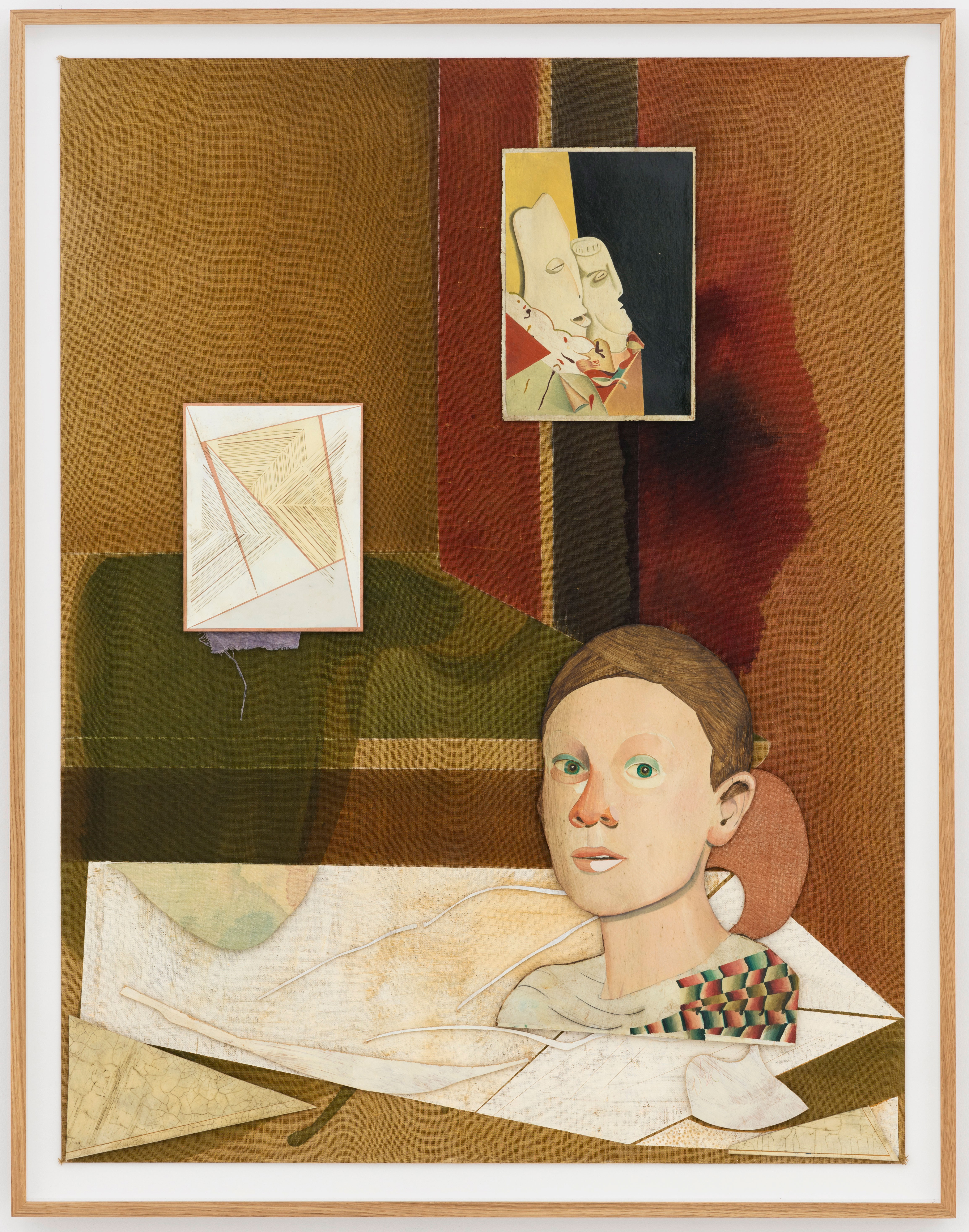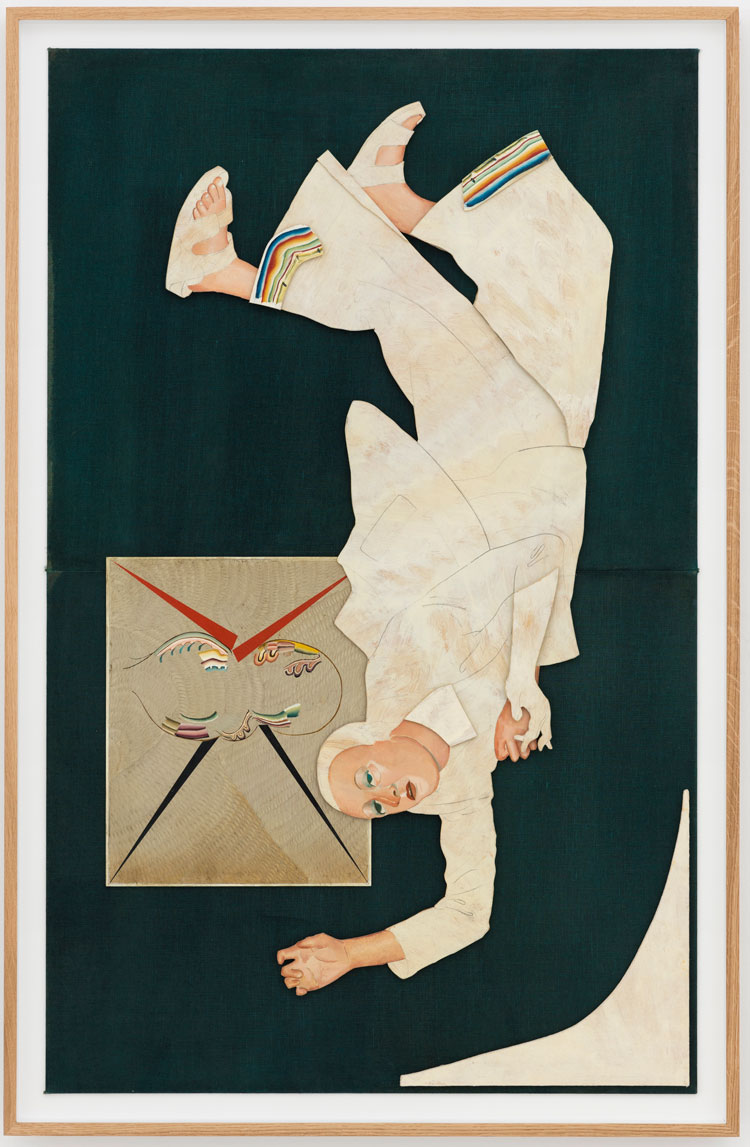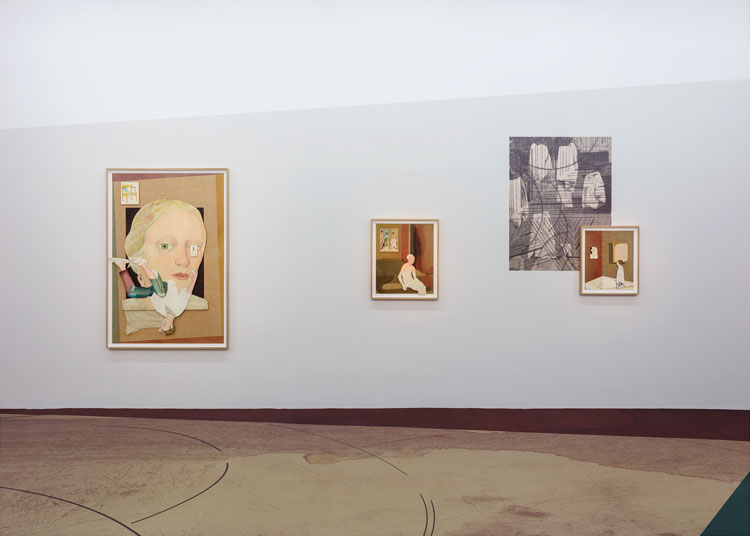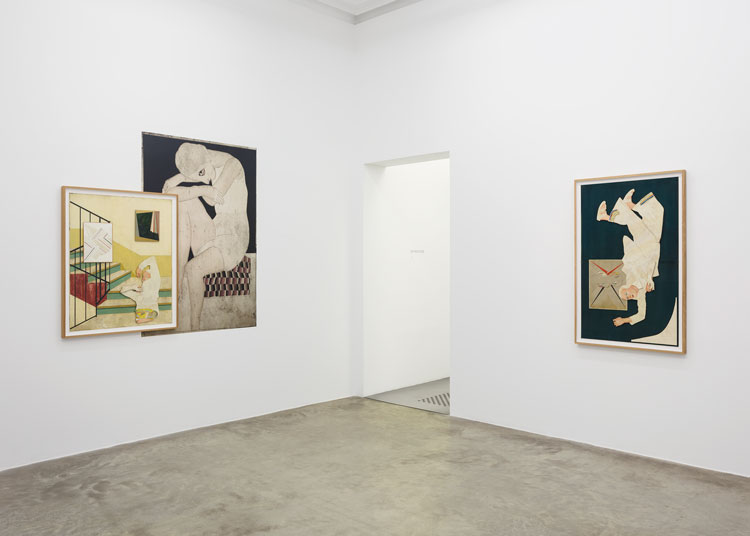

by JOE LLOYD
From symbolism to surrealism, Chagall to De Chirico, modern artists have often drawn inspiration their unconscious imaginings. Yet few have captured the texture of dream quite like the Swedish artist Jens Fänge (b1965). Fänge’s paintings are filled with things from conventional experience: people, furnishings, garments, artworks and staircases. But these everyday elements are arranged and appended in ways defying commonplace logic. A tiny staircase protrudes from the eye of an androgynous face; a woman lies on a carpet as if falling through space; a cat stretches like a yogi.
Grafting a range of materials – copper, Masonite, linen – on to his canvases to create assemblages, Fänge crafts uneasy three-dimensional spaces. Some appear like labyrinthine corridors, populated with miniature cubist paintings and sinuous, androgynous figures resembling those from Otto Dix. In Drömmarna, a 2018 survey at Stockholm’s Bonniers Konsthall, Fänge’s assemblages spilled out on to the museum’s walls and floors, blurring the border between artwork and architecture.
[image2]
Inner Songes, Fänge’s second exhibition at Galerie Perrotin, Paris, continues where Drömmarna left off. It features more than two dozen new works on canvas. Some are juxtaposed against and atop printed posters, themselves based on blown-up details from his works. The floor of one room has been covered in a carpet that echoes the background of a painting that hangs above it. As at Bonniers, Fänge has transformed the gallery itself into a sort of artwork. But while that show featured washed-out primary colours and elaborate postmodernist patterning, Inner Songes has a more muted, autumnal palette, as if viewed through sepia-toned memory.
Fänge, who works from his studio in Stockholm’s docklands, flew to Paris to install the exhibition, the first time he has left Sweden since start of the pandemic. Studio International spoke to Fänge during a busy morning of installation.
Joe Lloyd: In your 2018 exhibition at Bonniers Konsthall, paintings and assemblages blurred with the walls, and your new show at Perrotin features a carpet and large wall-posters. How do you decide how to hang your work, and do you have an idea before visiting the gallery?
Jens Fange: There’s a back and forth about where to place certain paintings, and so on. But even if there’s a fantastic model on SketchUp [3D design software], I have to see it in real life. To me, it’s very much like making an individual painting: installing paintings in a room is also a composition. And it follows similar rules to those I obey when I make my paintings and collages.
I’m continuing the ideas from Bonniers. At Bonniers, I made a few murals: although they were not actually murals, they were made out of wallpaper spreading over the whole wall, wrapped around a corner, and so on. I call them posters – but it’s also wallpaper glued to the wall – which sometimes have their origin in details from my paintings, or from photographs I’ve taken. And I’m going to install them with the paintings, a little bit like I’m trying to create the illusion of posters that are already hanging on the wall. A painting could partially cover a poster as if it’s ignoring its presence. I like the idea of uncertainty in the boundaries between my imagery and the real world, so to speak.
[image4]
JL: These assemblages have come to characterise your recent work. What do you like about the form?
JF: I don’t like the concept of progress or development in art but, nevertheless, my way of painting has changed over the years. I think it was formal practice that led me into making assemblages. Earlier, I was mainly painting in oil on canvas. Then, if I painted, say, an interior and wanted to place a person in the room, instead of immediately deciding where to put this little guy, I made a careful drawing and cut it out in paper so I could place it wherever I wanted. And I realised that this created possibilities and gave me a new sense of freedom. Then I gradually started to construct the paintings in that way.
JL: I like the idea of artwork as a construction. How do you construct a set of works for an exhibition?
JF: It’s very seldom that I start with a painting and work on it until it’s finished, then put it aside and start working on the next one. I’m partially driven by my impatience. I start with one painting, get tired of it, begin another one and another one. And so, in the end, I have perhaps 20 unfinished works floating around on my studio floor. And since I’ve been working with collage, I move bits and pieces and paintings within paintings around. Faces and figures move around and visit all the different plans before I decide where to finally put them. In a way, I’m driven by the tension between this total openness compared with the end result. I use glue to fix the pieces, so once I’ve decided, I can’t change it. But I want to keep the visual feeling of movement and possibility in the work.
[image6]
JL: Your assemblages feature numerous layers and materials: canvases, oil paint, copperplate, linen and Masonite. How do you begin an artwork?
JF: I try to start paintings in different ways, sometimes with a title, sometimes a small figure or a fragment of a figure, like a hand. Sometimes it’s the background, and the painting process starts with grounding a panel and adding colour or fabric to it. Even though I’ve been working as an artist for a long time, I guess I try to avoid a secure way of doing it. I try to come to a painting from a different angle each time.
JL: What inspired you to start painting for the first time?
JF: There are several answers to that. The easiest one is that I’ve always been drawing. Another is that when I was five years old, my father (a marine biologist) showed me a living fish that he had pinned down with needles on a board. He cut it open and showed me the inner organs and the beating heart of the fish. He used small needles, with red glass heads, which looked like drops of blood. It was a very intense situation: there was violence, but also tenderness and love from my father. Life and death. Small needles mimicking the blood that was in the fish’s beating heart. And I kept returning to that childhood memory.
Another thing: when I was 13, I went with my parents to France and we saw the Bayeux Tapestry. That was an important impulse, I would say: the whole imagery of that tapestry unfolding with a directness, in spite of the centuries passed.
[image7]
JL: Do you think your own work is similarly direct?
JF: I think they have a high degree of directness to me. But I’m also into contradictions, and some parts of a painting can be the opposite of direct. Some parts I carefully paint from stolen imagery, while others are spontaneous. So, it goes both ways, one could say. In the end, it’s very much based on intention, I would say, like tuning a piano.
I try not to think too much about the content in the early part of the progress. It’s more important for me to follow whatever ideas and mishaps occur. If I start out with a specific idea of how a painting should look, it never turns out that way. And if I get close to what I was expecting, it is usually a failure. When works move away from my initial ideas, it is usually for the better.
JL: Many of your paintings take place and play around with interior spaces: rooms, corridors and staircases. What interests you about these architectural features?
JF: I guess I need my figures – because they usually show up in a painting – to relate to something more or less solid, with a relationship to reality. And sometimes I realise I move quite far away from that. But even if the background looks abstract, it starts out with an idea of a floor and wall and a ceiling, which then bends over and loosens its shape. In a way, I also think of these architectural interiors as an image for my own psyche or mental interior. It’s like mental home-styling!
And I’m interested in architecture, of course. But I’m not interested in too much reference to specific artists. Sometimes, I’m happily surprised when someone points out to me associations with other artists. When I do use imagery from artists, I tend to regard it more as theft. I might trace a hand from some 15th-century German paintings, for example, and place it on a drawing taken from an ad I saw in a newspaper. So, it’s thievery rather than reference.
[image3]
I contradict myself, because in the new exhibition I do have two points of reference. The two largest pieces are big portraits and they both have a chair in them. One is the Paimio chair by the Finnish architect Alvar Aalto, the other [the BM-62 armchair] by the Danish designer Børge Mogensen. And I thought it was fair to include those in the titles of the works. The Aalto is an easy chair that is now a sought-after icon of design, but it was initially made for a sanatorium for tuberculosis patients, where everything was designed as part of the healing process: something far removed from the high-price collector’s item it has become. The other comes from an image I saw of a Mogensen chair with the upholstery twisted and woven like a basket. Not a very welcoming chair to sit on. And it intrigued me as an image of broken perfection.
JL: Did you paint the chairs from life?
JF: From memory. The broken chair was just an image, but I could immediately relate to it. The rate, the speed of the brokenness felt almost like a body memory of a kind. You could easily imagine what it would be like to use it.
For the Alvar Aalto chair, I made a small painting and then I cut it out, and the other chair is painted on a small copper plate. When I made them, I had no clear idea where to put them. I ended up using the Aalto chair to partially cover the eye in the portrait. It’s kind of abrupt, the image of a chair suddenly floating in front of a big painted face.
[image5]
JL: Your new exhibition is titled Inner Songes. Why?
JF: I was thinking back and forth. For the show I made at Bonniers, I kept the Swedish title, Drömmarna, which means the Dreams. Then I made a small painting for this show, called Inner Song, and I twisted it, then changed “Songs” to the French “Songes”, which means dreams. I liked that connection to my earlier work, but also the way of using two different languages together like that, which sounds like one thing to the ear, but means something else when reading it.
JL: Viewing your work, it strikes me as dreamlike. Familiar objects and settings appear, but in strange positions and juxtapositions.
JF: Dreams are important to me. It’s not necessarily that I’m making illustrations of my own dreams. It’s more that I’m interested in the structure, the narrative structure of dreams, how dreams are presented to us when we sleep and what we make out of them, and maybe also how they blend nonsense with important, heartfelt messages and memories.
[image10]
JL: Compared with some of your earlier paintings, which have bold, bright palettes, the work in Inner Songes feels subdued and autumnal. What precipitated the change?
JF: It just happened gradually, I think. But in a way, I think it might be a late reaction to paintings I did almost 12 years ago. I was very much into pinks and light blue, a pastel palette: something opposed to male painting, macho painting. But gradually I moved away from that. I always blame intuition. Sometimes now, I start out with the idea of making an almost pure white background, but in the end it comes out very subdued.
JL: Inner Songes will open to a Paris under curfew, but not lockdown. Has the pandemic affected your practice?
JF: From a work point of view, it hasn’t affected me that much. Most of the time, I work alone from my studio. So, in a way, it has meant an even higher degree of concentration than otherwise. Of course, I couldn’t help but be affected by what felt like a global depression. There aren’t references or allusions to the pandemic in my paintings, but I do think it’s possible to feel something that stems from the feeling in society when the paintings are made.
It struck me that the flight to Paris was the first time in more than a year since I’ve travelled abroad. The last time was for Perrotin in Shanghai. That was at the very beginning of the pandemic, and no one was really talking about it at that point. It’s strange how much has happened in a year.
• Jens Fänge: Inner Songes is at Galerie Perrotin, Paris, until 27 March 2021.
